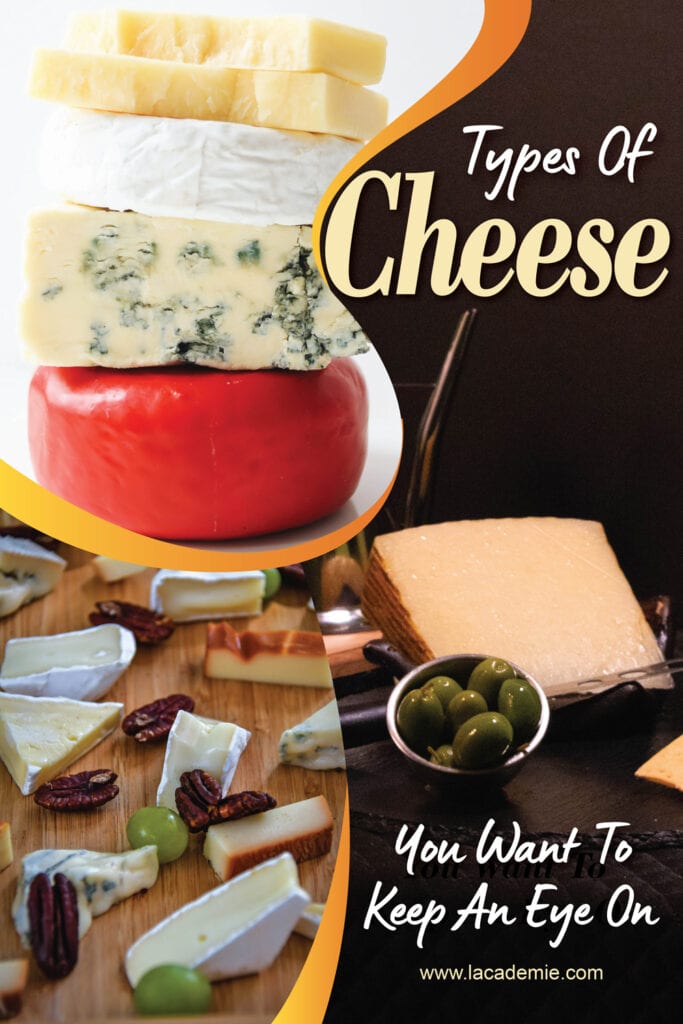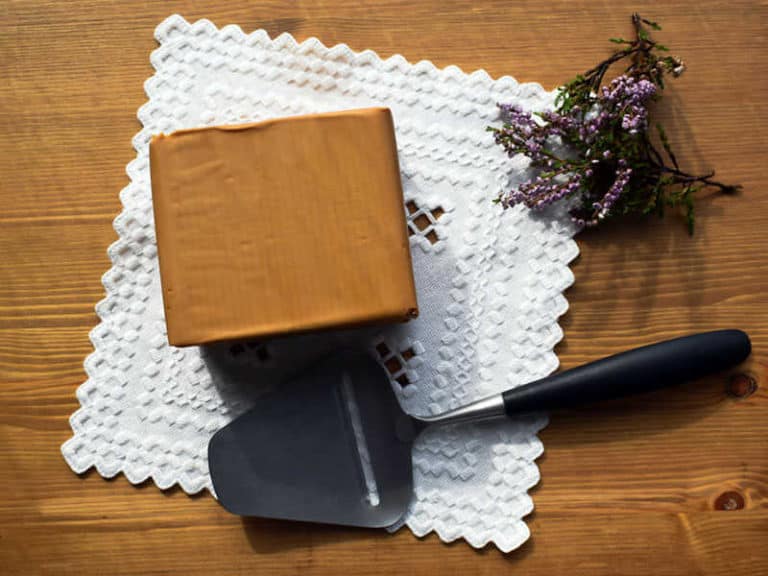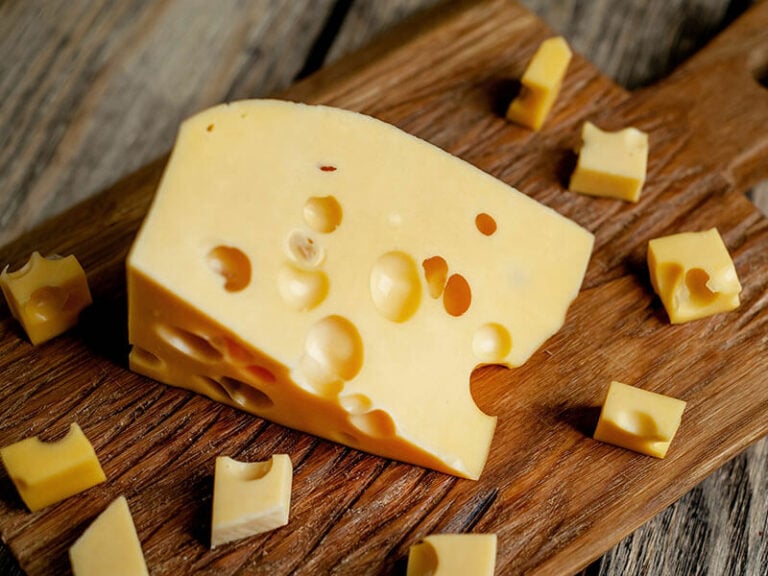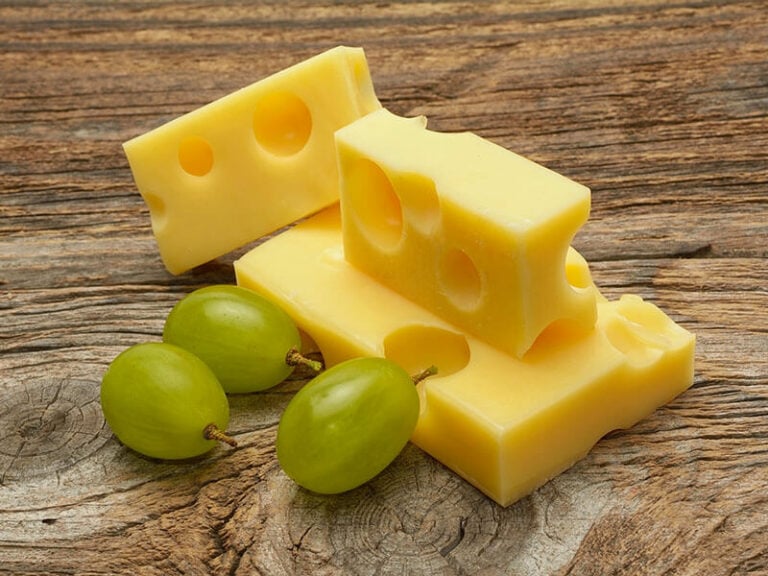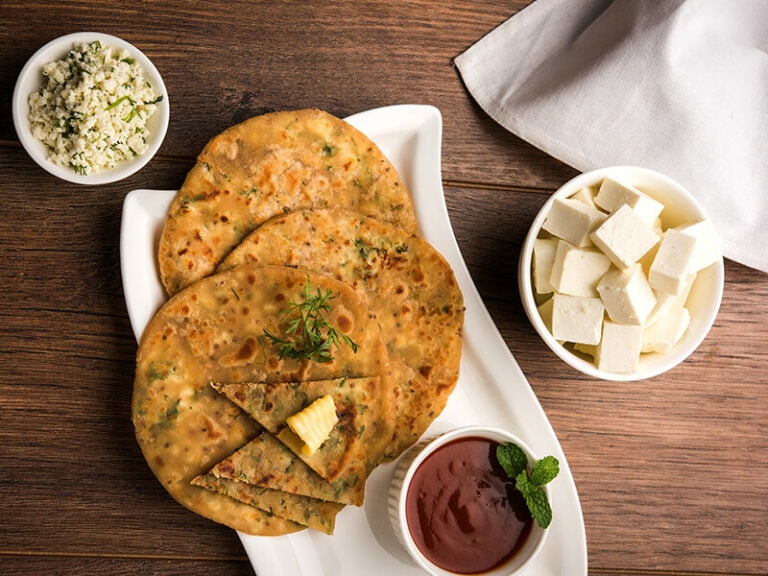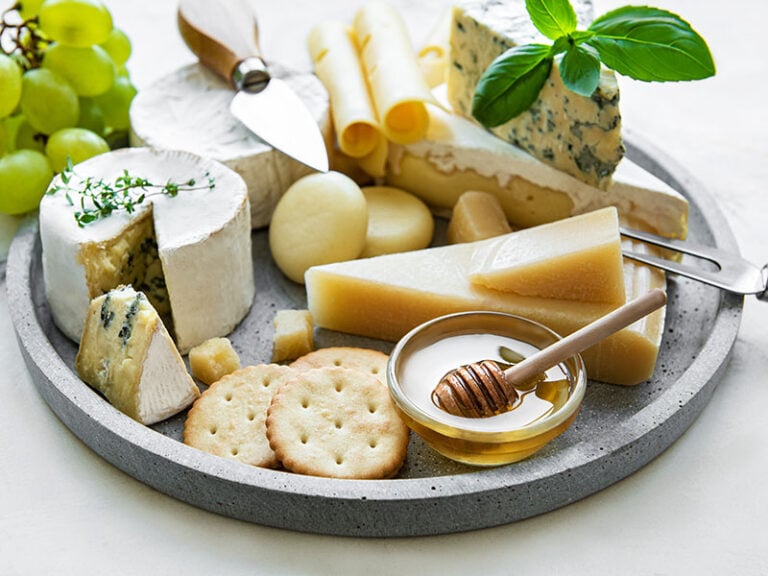How many types of cheese are there? The answer will surprise some of you. Until now, there are about 1,800 different types, and this number is expected to increase more and more. You can say the starting letter in these foods’ names ranges from a to z.
Of course, not every cheese is the same, and rest assured, you only want to enjoy the best of the best. If you are here today searching for such cheeses, you will be pleased. It’s time I cut to the chase and show you the best cheese types you don’t want to miss. Keep scrolling!
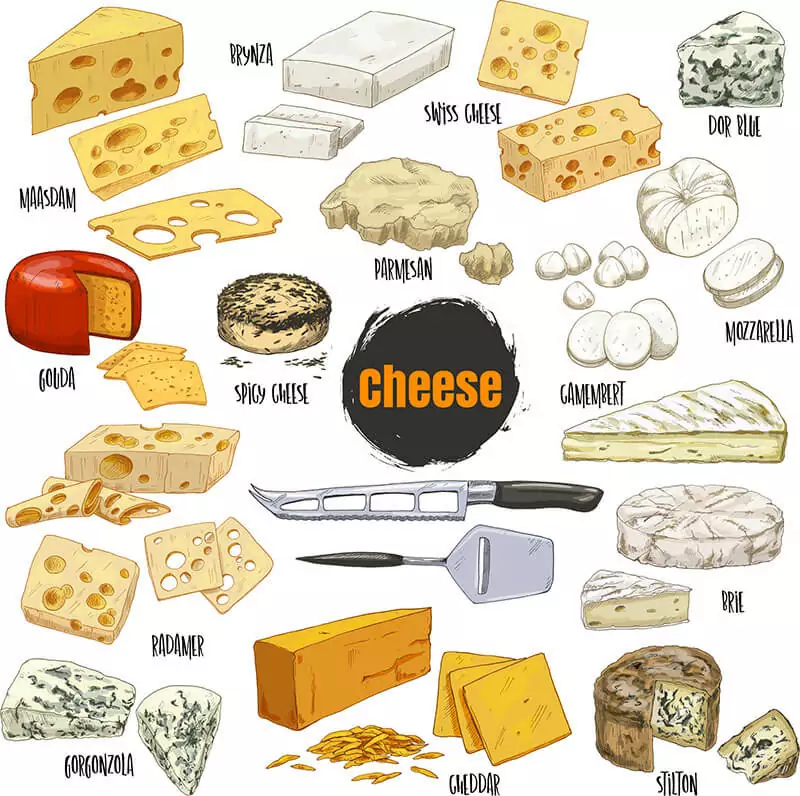
Every Type Of Cheese You Must Try Before You Die
Cheese lovers, there’s more than just the classic Mozzarella or the stinky Roquefort. You will explore more about the world of cheese with me via the section below, which covers some of the best kinds of cheese in this world!
The following list has been divided into small sections based on the characteristics of cheese, so you can learn more about them at the same time. Simply put, cheese is sorted into four groups as follows: age, production method, aging method, and moisture content.
Moreover, for eating cheeses easier, you might need a cheese fork, a variant of fork to poke and keep cheese in place.
Note: A cheese can fall into two or even three groups. For detailed information, read through the description of each cheese, and you should get the bigger picture.
Based On Age
You will often hear people say fresh and aged cheese, so what’s the deal with it? Well, those two terms are self-explanatory: fresh cheeses require no time to mature and typically involve no preservatives and very little processing.
Meanwhile, aged counterparts need several weeks to years for aging, resulting in products with different moisture content. Finally, there are whey cheeses, which are also fresh cheeses made with whey (obviously), a by-product of the cheesemaking process.
Fresh Cheeses
To make fresh cheeses, people will curdle and drain the milk to create the curd. It is then put into mold and pressed into blocks or wheels of cheese. They contain no preservatives, which means they will likely spoil without proper storage conditions, so watch out!
1. Cottage Cheese
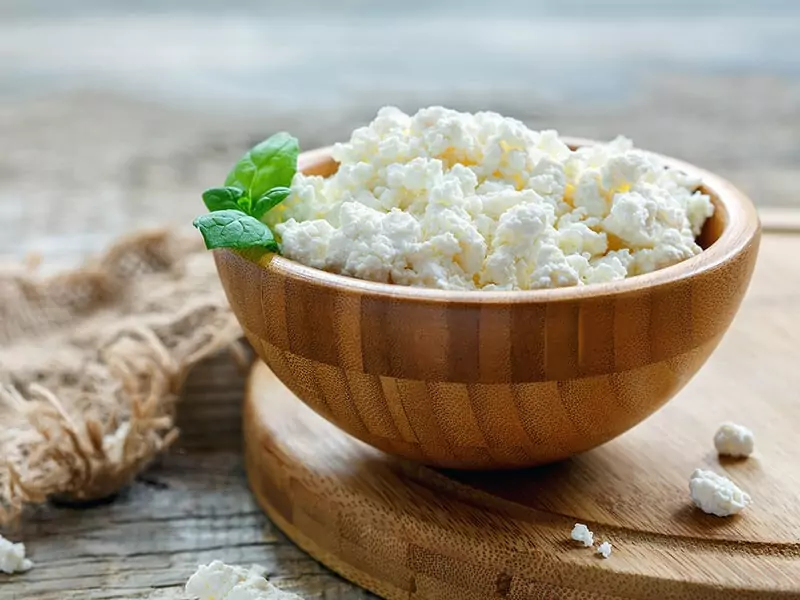
Cottage cheese does not taste like, well, cottage. In general, it is mild with just a subtle touch of saltiness and acidity. It has a soupy texture, making it a great substitute for mascarpone. If you are bothered by those unsettling pumps, just put it in a blender and voilà!
Besides promoting weight loss, which is the main reason why people choose cottage cheese over others, this soft, fresh cheese can improve bone health and regulate blood pressure. Its high protein content also makes it an ideal choice for athletes wanting to flex big muscles.
Highlight Characteristics
| Animal Milk | Cow’s milk, can be pasteurized or not |
| Fat Content | About 4% |
| Color | White |
| Aroma | Fresh |
| Texture | Creamy and crumbly |
| Flavor | Sweet |
Dive in for a brief, detailed introduction of Cottage cheese.
2. Cream Cheese
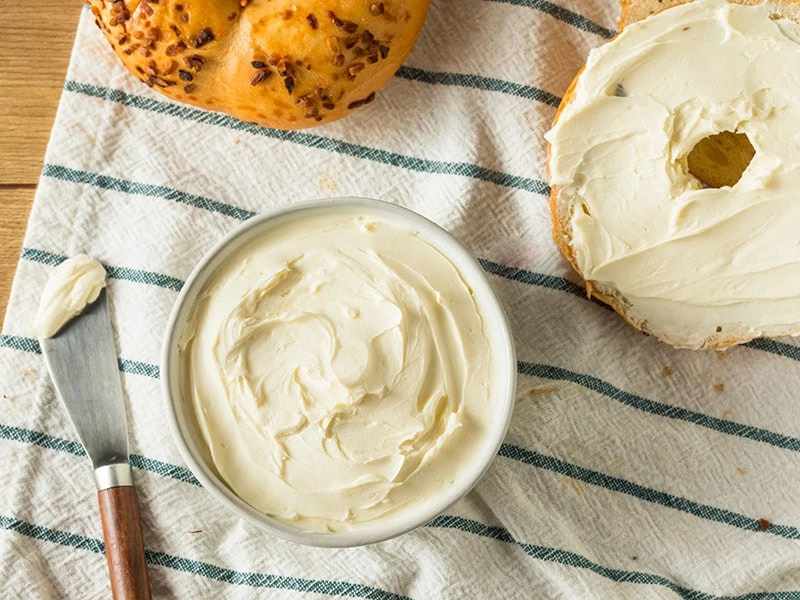
Many people have at least once wondered how long cheesecake can stay fresh. The answer depends on many factors, but cream cheese is never one of them. Although it does not have preservatives, the cheese can keep well in the fridge for 3-4 weeks.
With a sweet, somewhat tangy, and spreadable texture, cream cheese has many uses than just spreading on your morning toasts. You can use it to thicken sauces or to offer your foods an extra depth of creaminess, which is always welcome.
Highlight Characteristics
| Animal Milk | Cow’s milk, pasteurized |
| Fat Content | 65% |
| Color | White |
| Aroma | Fresh and pleasant |
| Texture | Creamy and spreadable |
| Flavor | Creamy, mild, and sweet |
3. Queso Fresco
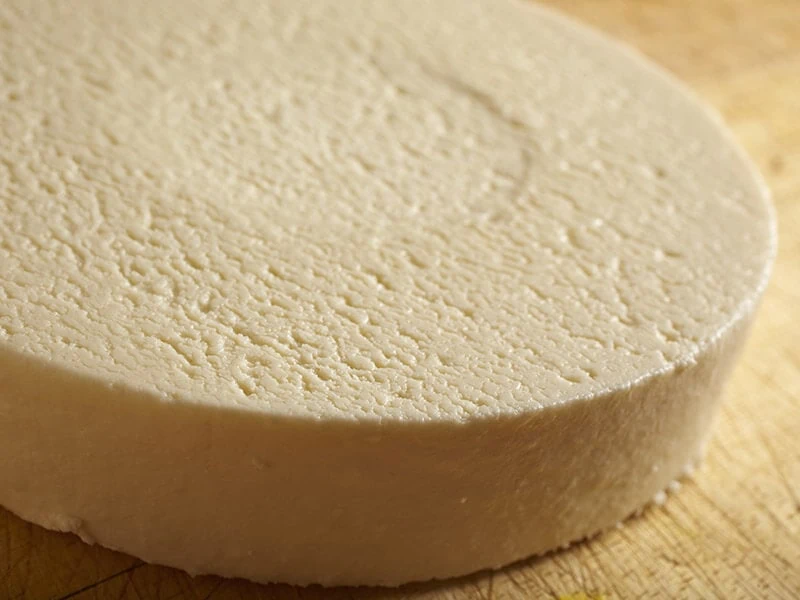
One of the staple Mexican cheese types, Queso Fresco is an indispensable element in empanadas or crispy fish tacos. The cheese is usually mistaken for Queso Blanco (but in fact a variant of it) and came to life in the early to mid-1800s.
Queso Fresco is not too good of a melter, but it is one of the best sprinklers in the game. You can put it over anything, from summer salads to winter soups. The cheese is made from cow and sometimes goat’s milk, resulting in a product with salty, tangy flavors.
Highlight Characteristics
| Animal Milk | Cow’s milk, sometimes blended with goat’s, often pasteurized |
| Fat Content | 44% |
| Color | Ivory |
| Aroma | Fresh |
| Texture | Firm and crumbly |
| Flavor | Mild, salty, and spicy |
Whey Cheeses
If you have ever wondered what Ricotta tastes like, the answer is to see it for yourself. Much like other whey cheeses, it is creamy and slightly acidic, leaving your palate with a refreshing aftertaste. Besides Ricotta, there’s Urda, Mató, and Brunost to add to your list.
4. Ricotta (Most Popular Mixed Milk Cheese)
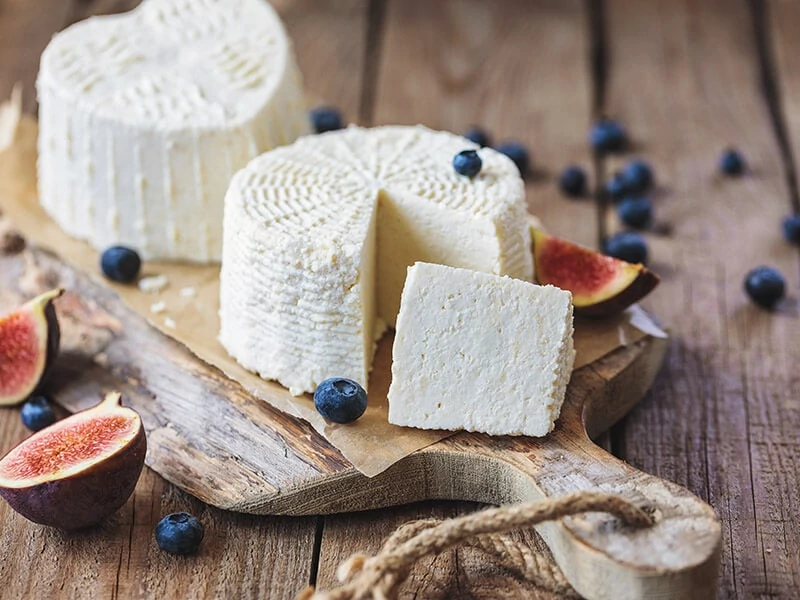
Add Ricotta to your list of must-try Italian cheeses now. Like other fresh cheeses, Ricotta has a smooth, spreadable texture that makes it a great match against bread and crackers. It is also a flavorful addition to sweet dishes like crepes or galettes.
Much to people’s surprise, Ricotta is not always made from cow’s milk. Variants derived from sheep, cow, and Italian buffalo’s milk can also be found easily these days, each with different fat content. There’s also aged variants, which are baked or fermented for extra flavors.
Highlight Characteristics
| Animal Milk | Cow, goat, sheep, and water buffalo’s milk, pasteurized |
| Fat Content | 10% |
| Color | White |
| Aroma | Fresh |
| Texture | Creamy and grainy |
| Flavor | Sweet and milky |
Quench your curiosity about how Ricotta is made with this video.
5. Urda
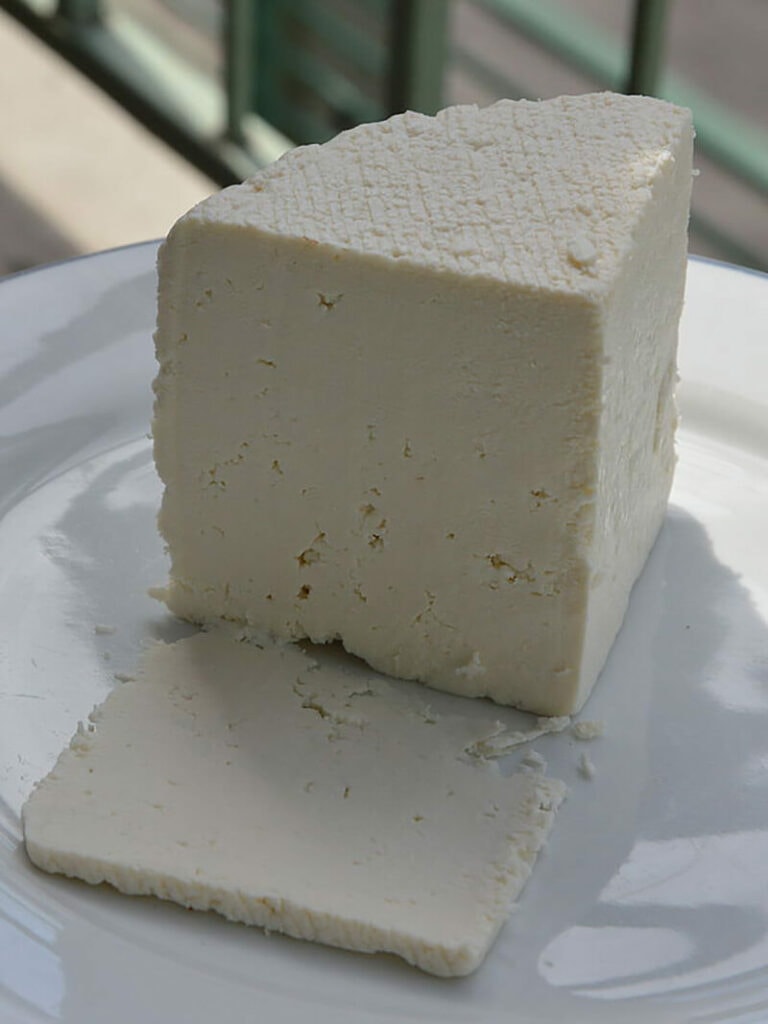
Urda makes an excellent substitute for ricotta.
With such texture, people sometimes regard Urda as a kind of soft cheeses. However, it is made from sheep’s, goat’s, and cow’s milk, with every bite taken being full of sweet desires.
Although the cheese is best known for its participation in Romanian desserts, you may find it prevalent in Bulgaria, Hungary, and other countries as well. Its sweet, milky flavor is concrete proof that the cheese should belong to your kitchen.
Highlight Characteristics
| Animal Milk | Cow’s, goat’s, and sheep’s milk, traditionally unpasteurized |
| Fat Content | About 22% |
| Color | White |
| Aroma | Fresh |
| Texture | Smooth, crumbly, and grainy |
| Flavor | Sweet and milky |
6. Brocciu
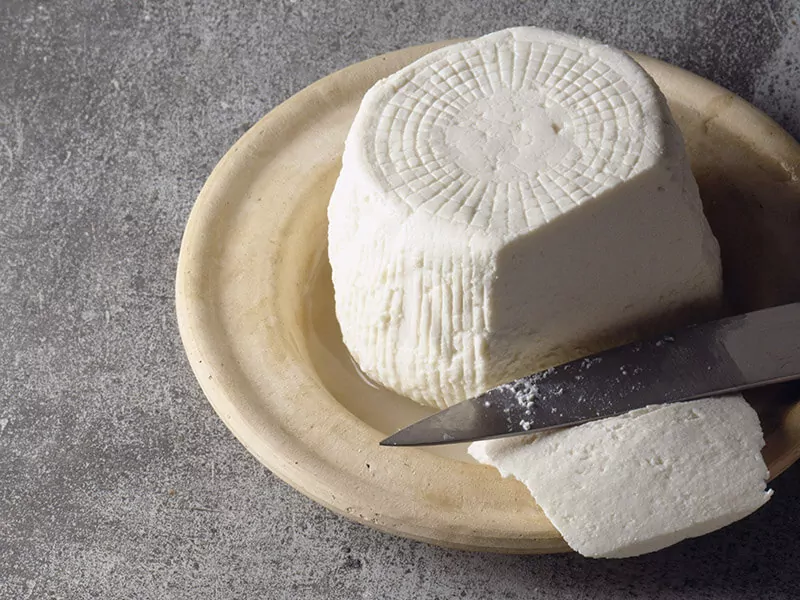
Beneath this Corsican cheese’s smooth, crumbly exterior lies a hidden surprise waiting to be discovered. Indeed, it is you who has that honor; slide the knife, and here goes a mild, sweet aroma tempting you into having a taste.
The cheese tastes pretty similar to how it smells. A hint of sweetness leads the way, followed by a flicker of milkiness complemented with tangy nuances. Surprisingly, the cheese is made from both milk and whey, yet classified as a whey cheese.
Highlight Characteristics
| Animal Milk | Goat’s or sheep’s milk, pasteurized |
| Fat Content | 40-50% |
| Color | White |
| Aroma | Sweet |
| Texture | Smooth, creamy, and crumbly |
| Flavor | Sweet and milky |
Aged Cheeses
Like fine wine, cheeses when aged become more flavorful. The process does not just offer a flavor boost but also gives your product a new look, often a more crumbly texture. Examples of aged cheeses include Gouda, Asiago, and Banon.
7. Gouda
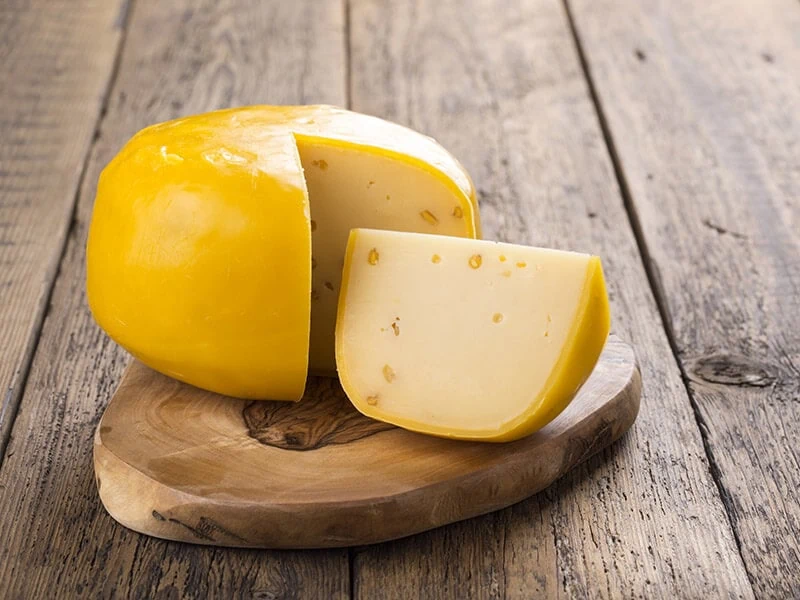
Without further doubts, Gouda is the most favorite Dutch cheese on this planet. It is probably one of the oldest cheeses that still exists today, with its first record being in 1184. Today, cheese is produced extensively, and some still follow the traditional method.
Typically, Gouda is aged for several weeks, but the process can last up to seven years. This gives the cheese a more pronounced flavor, which is reminiscent of butterscotch with added saltiness. It’s a stellar melter for fondue, grilled sandwiches, and so on.
Highlight Characteristics
| Animal Milk | Cow, goat, or sheep’s milk, can be pasteurized or not |
| Fat Content | 31% |
| Color | Yellow |
| Aroma | Pungent |
| Texture | Compact, crumbly, and springy |
| Flavor | Creamy, nutty, and sweet |
Here’s a quick breakdown of the production of Gouda.
8. Asiago
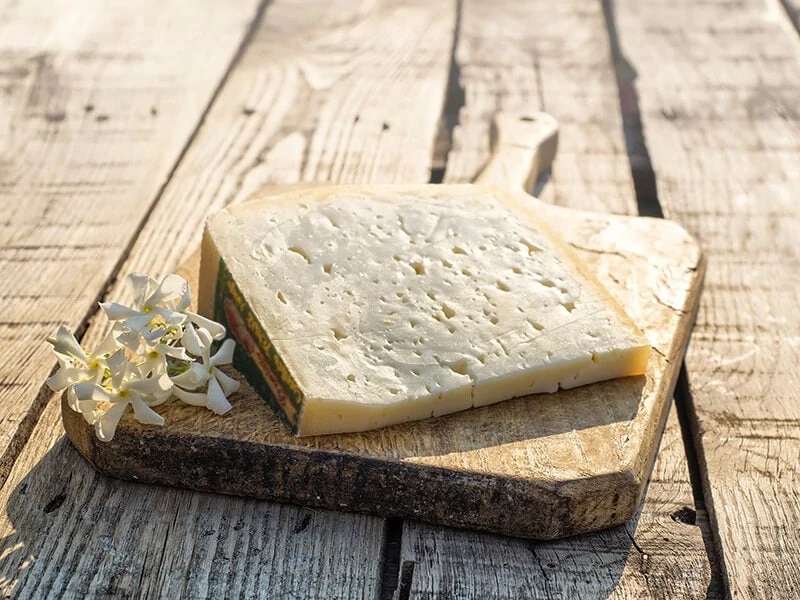
A softer alternative (in terms of texture) for Parmesan or Romano, Asiago looks like the best candidate on your shortlist. It is a staple of Italy, specifically Veneto and Trentino, and is known for its smooth yet pronounced flavor profile.
While fresh Asiago is more friendly, you don’t want to miss out on its aged version that takes around 9 months and upwards to mature. It develops a strong flavor, and what other ways to balance out such intensity with a glass of Chianti or Riesling?
Highlight Characteristics
| Animal Milk | Traditionally sheep’s, now cow’s milk, pasteurized |
| Fat Content | 34-48% |
| Color | Yellow |
| Aroma | Pungent |
| Texture | Smooth, crumbly, compact, and open |
| Flavor | Mild to sharp, full-flavored, and milky |
9. Banon
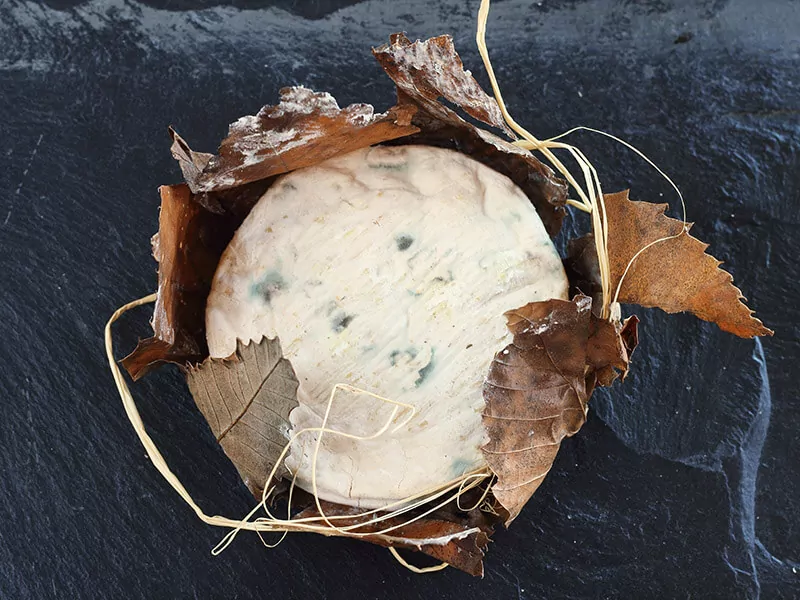
Banon doesn’t like to be seen. The cheese is carefully wrapped in chestnut leaves and takes you by surprise with its complex depths of flavor. A sharp kick conquers your palate, washed down by earthy, goaty nuances, and is finished with a slight acridity.
Flavor-wise, what makes Banon so special is how it is made. At a tender age, people will put the cheese into an earthenware jar and season it with salt and pepper. After that, the product is doused with vinegar and eau-de-vie, which gives the cheese its fierce profile.
Highlight Characteristics
| Animal Milk | Goat’s milk, unpasteurized |
| Fat Content | 45% |
| Color | White |
| Aroma | Strong |
| Texture | Creamy, smooth, and sticky |
| Flavor | Strong, fruity, and woody |
Based On Production Method
Not every cheese is made the same. As you know, cheese is made from curd, which can be processed using one of the following methods: stretched curd (widely known as pasta filata) and cooked pressed.
Stretched Curd Cheeses (Pasta Filata Cheeses)
To make these cheeses, the curd must be fully submerged in warm water until it reaches the desired elasticity. After that, people will knead it, then pull it (or stretch it), and the results are products with a chewy, springy texture like Mozzarella, Halloumi, and Provolone.
10. Mozzarella
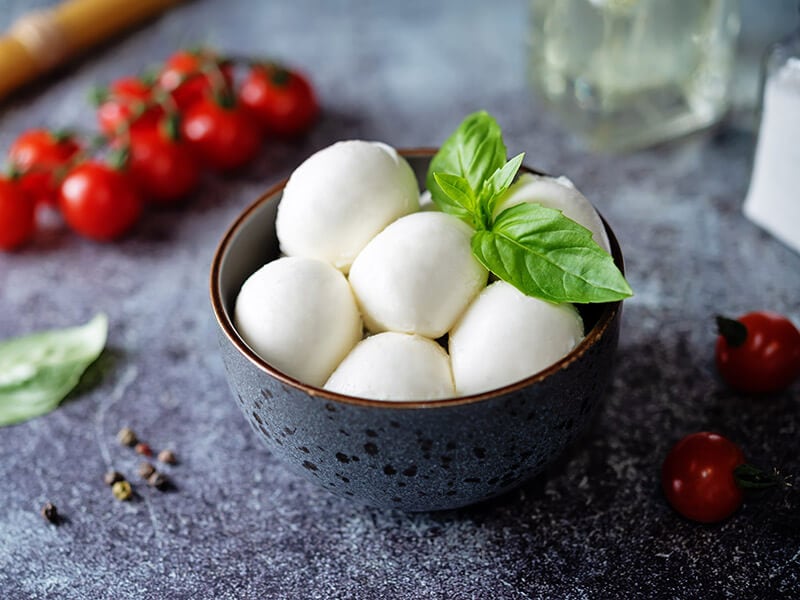
If you believe that Mozzarella tops the list, you are not wrong. In fact, many people share the same idea, claiming that Mozzarella is genuinely one of the best since it has a delicate flavor and takes kindly to many foods, be it crackers or a glass of Port.
The southern Italian cheese was invented in 1570 via the pasta filata method, a process also known as “stretched curd” or “spun paste.” To put it simply, Mozzarella will be plasticized and kneaded in hot water, resulting in a dairy product with desirable cooking features.
Highlight Characteristics
| Animal Milk | Italian Mediterranean buffalo’s milk traditionally, sometimes cow’s, sheep’s, and goat’s milk Can be pasteurized or not |
| Fat Content | 45% |
| Color | Can be white or light yellow depending on the animal’s diet |
| Aroma | Fresh and milky |
| Texture | Springy and supple |
| Flavor | Milky |
Let’s travel back in time and see how Mozzarella was born.
11. Halloumi
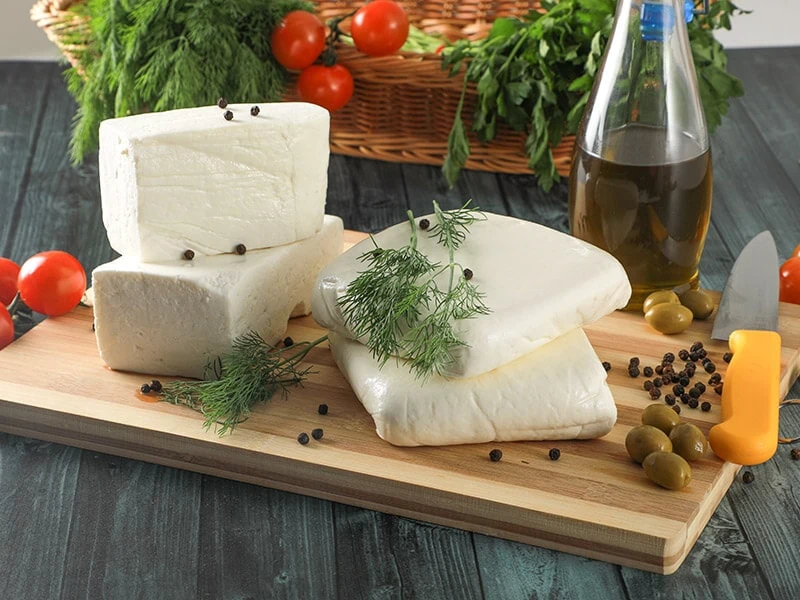
Looking for some BBQ party starter ideas? Grilled Halloumi is more than a nice choice. Even when served fresh, the cheese would still satisfy you and your family’s cravings with a chewy and creamy texture, unveiling savory notes as it lingers on your palate.
Traditionally, people use goat’s milk to make Halloumi, but cow and sheep’s milk also go into production these days and are often pasteurized. The cheese is incredibly rich in protein and calcium, so don’t hesitate to add it to your meal rotation if you wish to gain some muscles.
Highlight Characteristics
| Animal Milk | Goat’s milk, sometimes sheep’s or cow’s milk Traditionally unpasteurized, commercially pasteurized |
| Fat Content | 25% (47% in dry matter) |
| Color | White |
| Aroma | Strong |
| Texture | Chewy, creamy, firm, and springy |
| Flavor | Salty, savory, and tangy |
12. Provolone
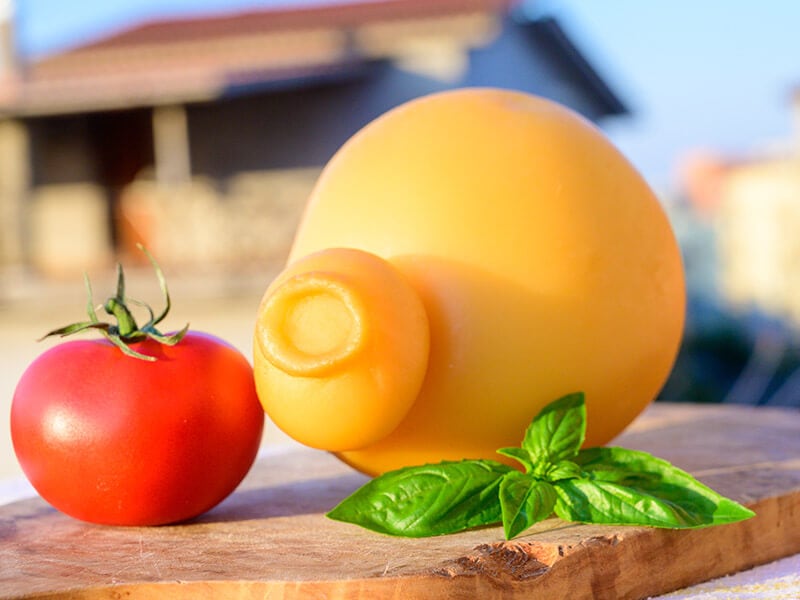
Provolone finds its origin in Val Panada, Southern Italy, where the cows graze deliberately at the banks of Po river. Thanks to them and the hard work of local cheesemakers, the result is a dairy product that stands the test of time.
Provolone takes on a mild, buttery flavor, complemented with nutty undertones and a smooth finish that will be etched in your mind for good. In particular, the Dolce version leans towards the sweet side more, whereas the Piccante is more dramatic in taste.
Highlight Characteristics
| Animal Milk | Cow’s milk, can be pasteurized or not |
| Fat Content | 27% |
| Color | Pale yellow |
| Aroma | Pleasant |
| Texture | Firm, grainy, and open |
| Flavor | Buttery, mild, sharp, spicy, sweet, and tangy |
Cooked Pressed Cheeses
On the other hand, these cheeses have their curd heated (at a temperature of 45 degrees or more) before being pressed into shapes. If you’re worrying whether cheese contains gluten or not, then cooked pressed cheese is a safe bet.
Case in point, the two Swiss cheeses Gruyère and Emmental, belong to this category, along with Cheddar, Edam, and Monterey Jack.
13. Emmental
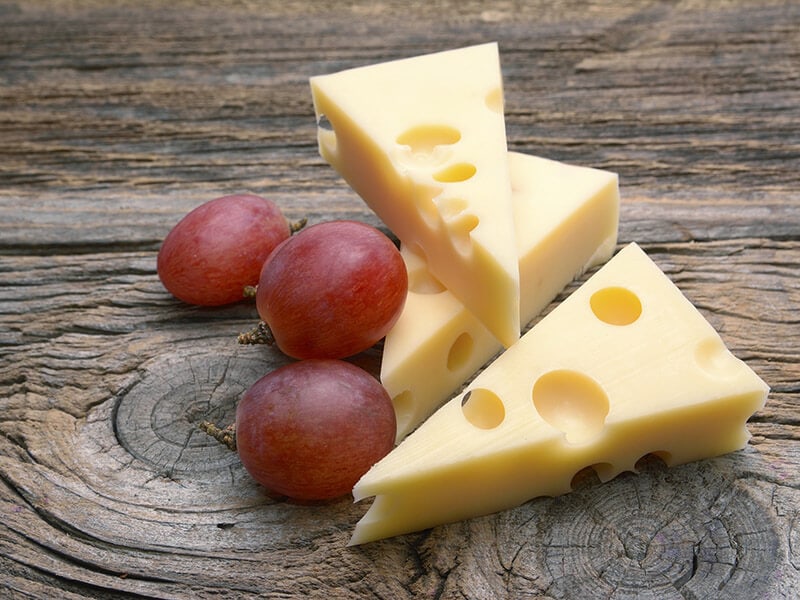
What makes Emmental skyrocket to fame and become one of the most popular Swiss cheeses in the world? Some chalk that up to its unique appearance, but others assert that the cheese shines because of how it tastes. Perhaps it’s both.
Past the rind, the cheese invites you to a symphony of flavors, beginning with a solo of fruity nuances. Then, nutty undertones come in as a support, and the curtain calls with a delightful buttery flavor that makes you want to see it again and again.
Highlight Characteristics
| Animal Milk | Cow’s milk, often pasteurized |
| Fat Content | 28% |
| Color | Yellow |
| Aroma | Sweet, hay-like |
| Texture | Medium-hard |
| Flavor | Mild and savory |
Check out this in-depth explanation of why Swiss cheeses like Emmental are full of holes.
14. Gruyère
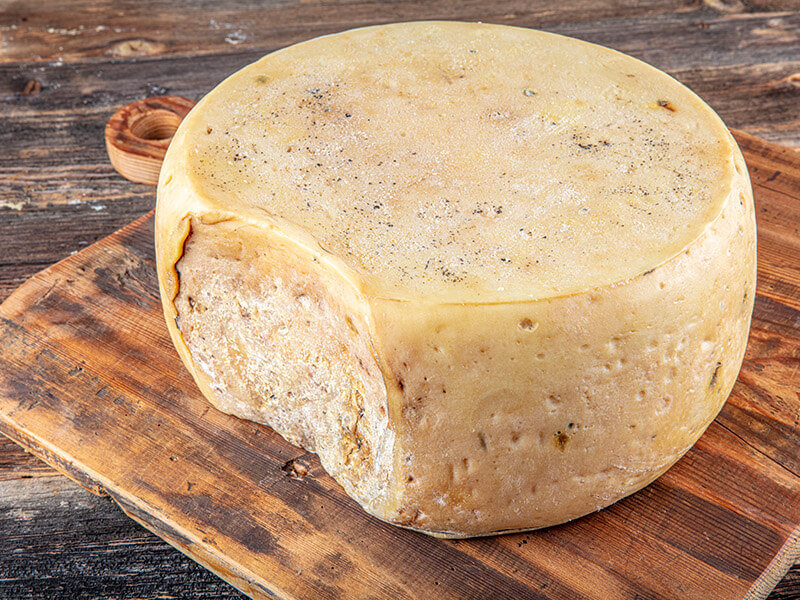
Besides Emmental, Gruyère is another great cheese of Switzerland. The unpasteurized hard cheese has a smooth pale yellow interior with various holes encased by a wrinkled rind.
When cut open, the cheese will take you on a sweet, full-flavored journey. The fruity nuances will gently kiss your palate, then move on to a nutty hint, followed by a smooth aftertaste that makes your tasting experience truly worthwhile.
With such intricate flavors, Gruyère requires no pairings. If you wish, you can still have it with fruits and nuts or put a gooey, cheesy twist on your baked dishes with it.
Highlight Characteristics
| Animal Milk | Cow’s milk, unpasteurized |
| Fat Content | 49-53% |
| Color | Pale yellow |
| Aroma | Earthy |
| Texture | Compact |
| Flavor | Sweet |
Gruyère cheese is highly treasured in Switzerland, and here’s why.
15. Appenzeller
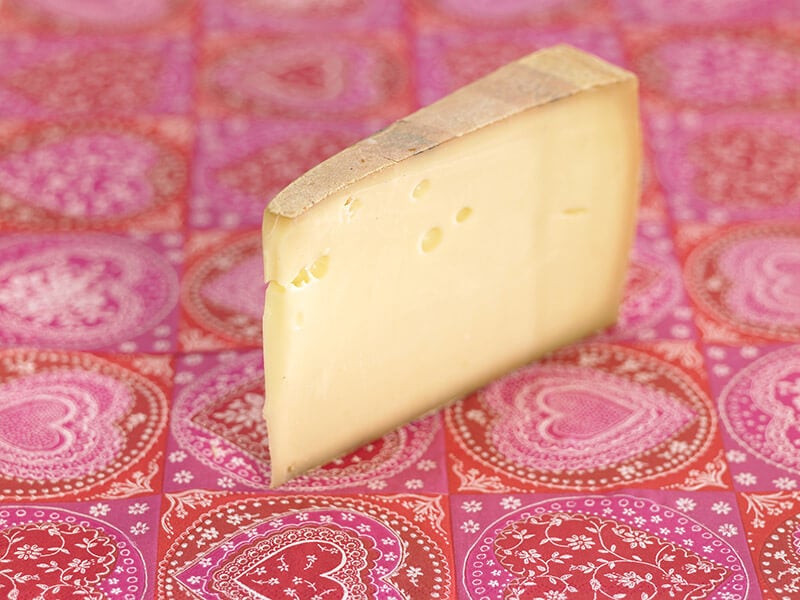
Appenzeller is also a Swiss cheese, which has tiny holes interspersed over its body encased in a golden rind that’s edible in its youth. Past the rind, the cheese shows off a straw-colored paste hidden with flavorful surprises.
When shopping for Appenzeller, don’t forget to check out the color of the label. Silver means “Classic,” the mild variety aged around 3-4 months, while gold and black is identified with the “Surchoix” and “Extra,” varieties, respectively.
Highlight Characteristics
| Animal Milk | Cow’s milk; unpasteurized |
| Fat Content | 11% |
| Color | Straw |
| Aroma | Mild |
| Texture | Smooth, firm, and open |
| Flavor | Fruity, spicy, and tangy |
Based On The Addition Of Mold
Indeed, I’m not talking about those fuzzy molds that make you, say, doubt whether that block of newly-bought Feta is still fresh. What I meant is those safe molds inoculated into the paste while the cheese is still in production, which imparts strong, distinctive flavors to the product.
Soft-Ripened Cheeses
Soft-ripened cheeses like Brie or Camembert are exposed to mold, which helps develop this chalky rind that adds to the cheese’s overall flavor. This is the result of exposure to mold like P. camemberti, starting from the exterior inwards.
16. Brie
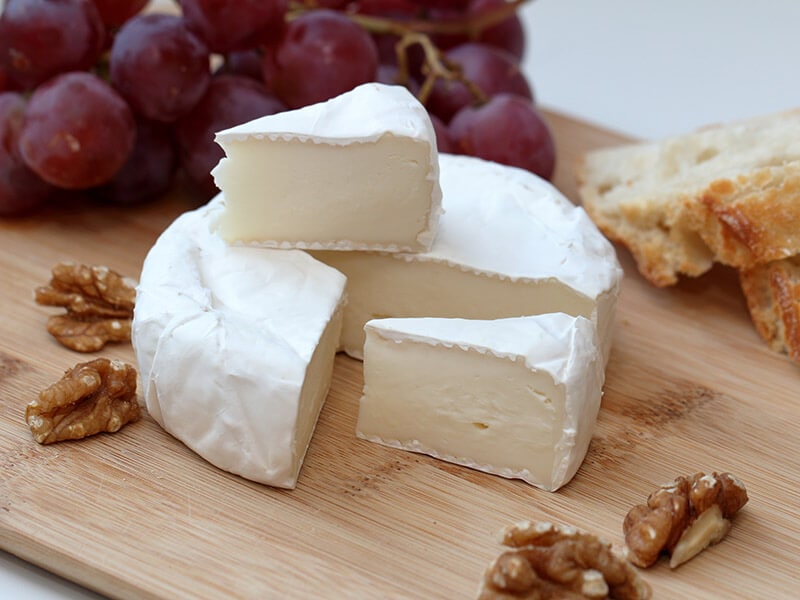
Another French cheese on the list, Brie is a soft cow’s milk cheese with an edible downy rind made of Penicillium Camemberti. With wonderful flavors and textures, there is no surprise to see Brie cheese brands score great reviews on shopping platforms.
Of course, you have more serving options than just cold meat. If you want something simple to appreciate its buttery richness, bring out some bread or crackers. Brie also takes the front in plenty of appetizers, salads, and desserts.
Highlight Characteristics
| Animal Milk | Cow’s milk, unpasteurized |
| Fat Content | 8.4% |
| Color | Cream |
| Aroma | Pronounced |
| Texture | Buttery, runny, and soft-ripened |
| Flavor | Mild, buttery, and creamy |
17. Camembert
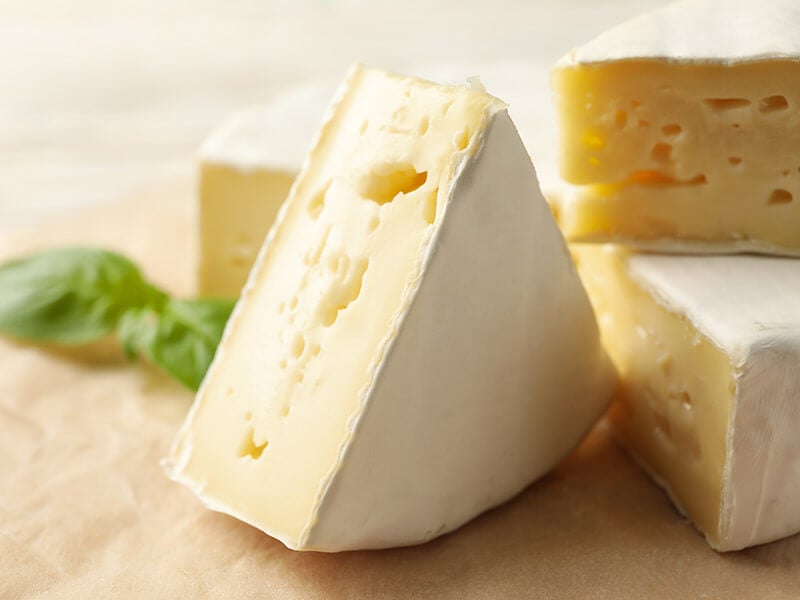
Originating from Normandy, France, Camembert is an excellent substitute for Brie as the two products share many similar traits. However, Camembert is fully covered in rind, which leads to a more pungent aroma that can either make your mouth water or get a headache.
In case it’s the latter, you will still love Camembert. It delivers such a flavor that no words can describe it with accuracy. If you have a good nose, you can even sense a hint of mushrooms in it. The best way to serve it is to bake the whole wheel and bring out the dunking goodies!
Highlight Characteristics
| Animal Milk | Cow’s milk, unpasteurized |
| Fat Content | 45% |
| Color | Pale yellow |
| Aroma | Earthy |
| Texture | Smooth, soft, chalky, and runny |
| Flavor | Rich, buttery, and creamy |
Let’s find out how the French Camembert comes to life.
18. Humboldt Fog
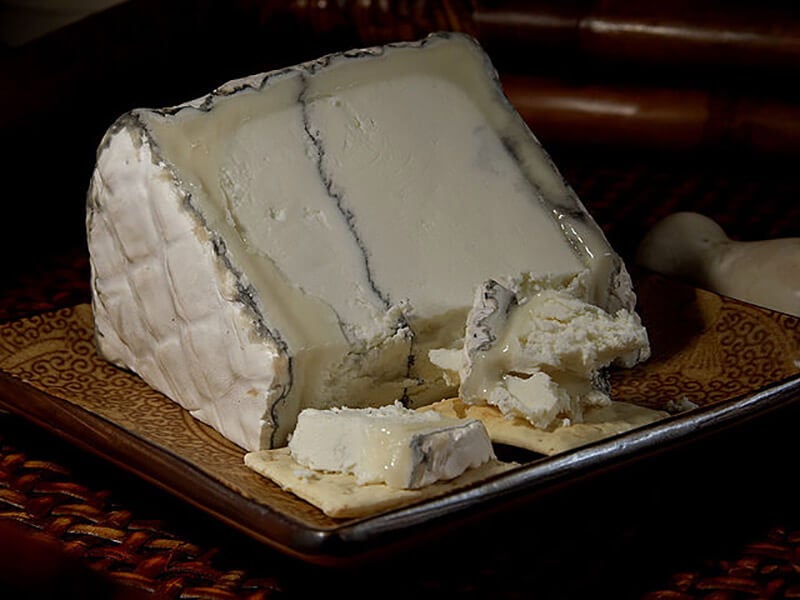
You may have guessed it: the name of this cheese is a tribute to the ocean fog rolling in from Humboldt Bay, Northern California. Mary Keehn, the great mind behind the cheese, revealed that the idea of making it came in a dream.
Dreams do come true, don’t they? In the late 20th century, after having taken inspiration from French counterparts, Humboldt Fog came into existence. Boasting a sweet aroma, the cheese promises to suit all palates with its creamy body and buttery taste.
Highlight Characteristics
| Animal Milk | Goat’s milk, pasteurized |
| Fat Content | 11% |
| Color | White |
| Aroma | Slightly sweet |
| Texture | Soft, creamy, and flaky |
| Flavor | Buttery and creamy |
Washed-Rind Cheeses
Washed-rind cheeses are treated in opposite manners: they ripen inwards, and as the name suggests, their rind is cured with saltwater brine, at times mold-bearing agents such as wine, beer, or spices, making it susceptible to a class of mold named Brevibacterium linens.
19. Limburger
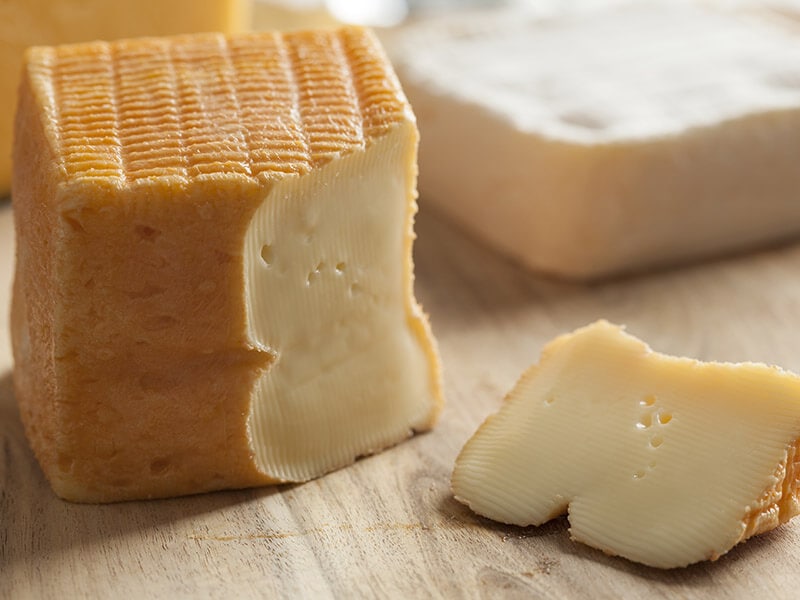
What’s that funky smell? You have probably walked past some Limburger, a cheese made in the Duchy of Limburg. Its smell is so overpowering that people make use of it to fight malaria in Africa (since it can scare off mosquitoes).
To some, Limburger is pretty mild in taste. It is lifted to another dimension with notes of grass and mushroom and ends delightfully in your mouth with a delicate tang. People usually have this cheese with rye bread and onion, with beverage options including coffee and lager beer.
Highlight Characteristics
| Animal Milk | Cow’s milk, pasteurized |
| Fat Content | 27% (42% in dry matter) |
| Color | Straw |
| Aroma | Stinky |
| Texture | Creamy, crumbly, firm, and smooth |
| Flavor | Grassy, mild, and mushroomy |
20. Reblochon
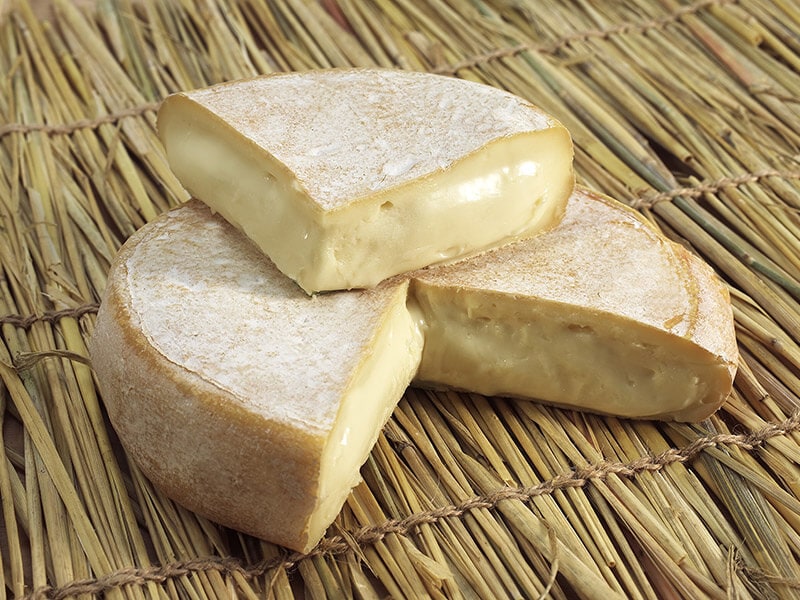
Once you get to know more about Reblochon, you will fall for it for sure. The cheese’s name is derived from the French verb reblocher (to remilk), which refers to the second milking that yields a product with higher fat content.
Given that, Reblochon is not just pleasant on the eye but also in your mouth. Its smooth and creamy texture is complemented with a mild fruity taste and a nutty finish, which makes it an exceptional addition to baked dishes or any cheese board.
Highlight Characteristics
| Animal Milk | Cow’s milk, unpasteurized |
| Fat Content | 45% |
| Color | Ivory |
| Aroma | Earthy and herbal |
| Texture | Close, compact, smooth, and supple |
| Flavor | Fruity, mild, and nutty |
21. Taleggio
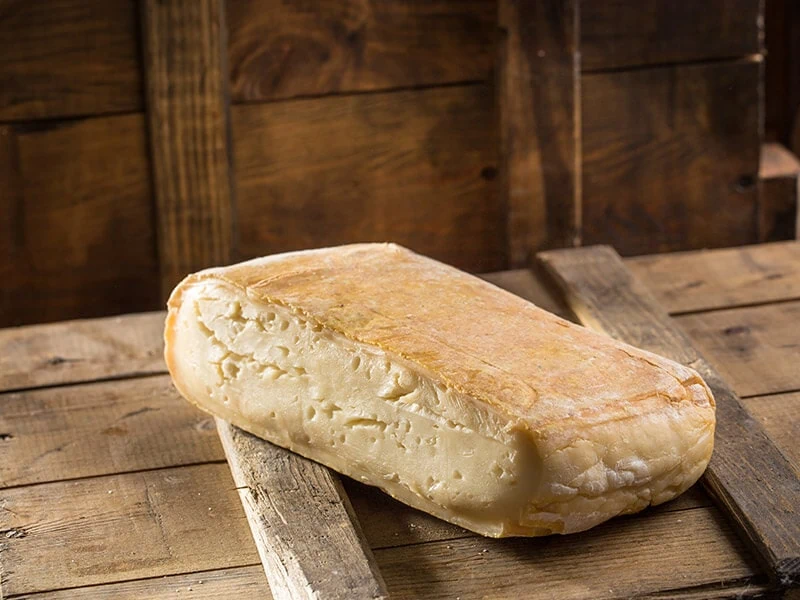
Taleggio is a soft, washed-rind cheese produced every autumn and winter. Made from cow’s milk, the cheese is inoculated with five kinds of mold to produce the red smear, giving it a unique look and flavor.
After 6-10 weeks, the cheese is ready to serve. Taleggio flaunts a mellow composition at the first bite, bursting with fruity and buttery specks. A tangy finish kicks in, ensuring that you are pleased to the extremes until the very last crumbs.
Highlight Characteristics
| Animal Milk | Cow’s milk, can be pasteurized or not |
| Fat Content | 48% |
| Color | Pale yellow |
| Aroma | Pungent and strong |
| Texture | Creamy |
| Flavor | Fruity, mild, and tangy |
Blue-Veined Cheeses
When it comes to blue cheese and its varieties, opinions are divided. While some believe they stand among the greatest foods, others frown upon that idea or are even grossed out by such products. If you belong to the second group, the choices below will change your mind.
22. Gorgonzola
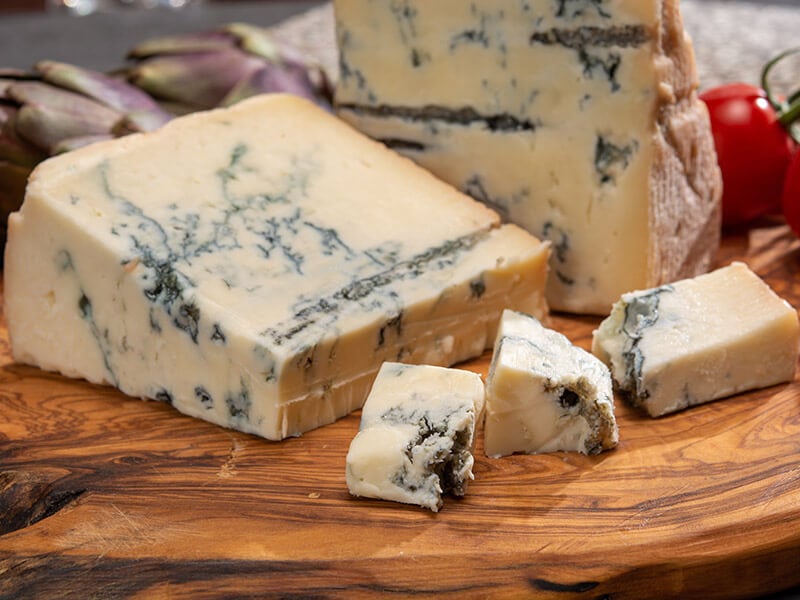
One of the world’s most ancient blue-veined cheeses, Gorgonzola has earned much praise it deserves throughout the flow of history. Strangely enough, some people muddle up between Gorgonzola and blue cheese, but Gorgonzola itself is already a blue cheese.
There’s a myth that Gorgonzola is very strong and not suitable for newbies, but let’s bury this myth: it is mild and even slightly sweet in taste. Should you find its aroma too potent to serve it on its own, feel free to incorporate the cheese into your favorite pasta or salads.
Highlight Characteristics
| Animal Milk | Cow’s milk, pasteurized |
| Fat Content | 25-35% |
| Color | Yellow |
| Aroma | Nutty |
| Texture | Firm and crumbly |
| Flavor | Mild to sharp depending on the aging time |
23. Roquefort
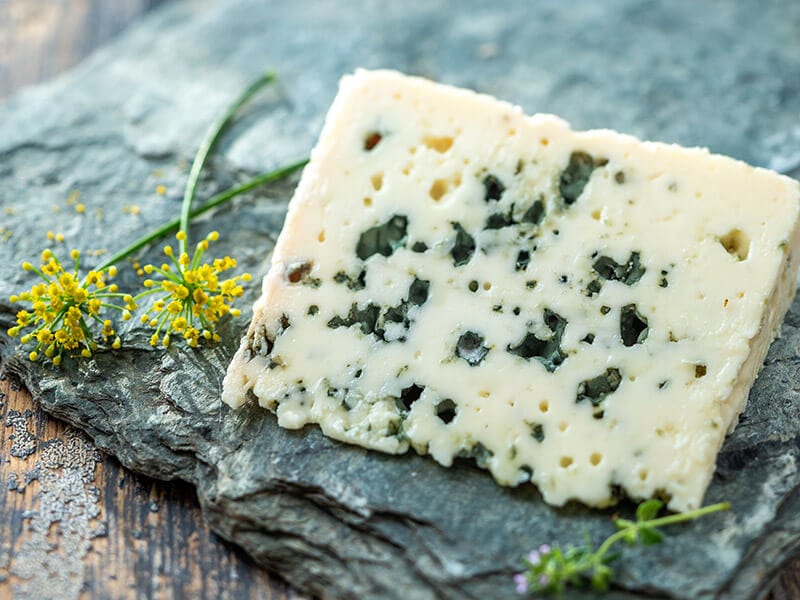
Nine out of ten blue cheese lovers will tell you that Roquefort is one of their favorites, and it’s a fact. Why? Admittedly, its funky smell is not too tempting, but once you have gotten over it, the cheese will make your taste buds jump for joy.
Take a small bite, and you will be greeted with such an exquisite taste that even Emperor Charlemagne is in love with (which explains its local name “cheese of kings and popes”). It is creamy, tangy, and sharp, pretty much what you need to kick your recipes up a notch or two.
Highlight Characteristics
| Animal Milk | Sheep’s milk, pasteurized |
| Fat Content | 31% |
| Color | Blue |
| Aroma | Very strong |
| Texture | Creamy and crumbly |
| Flavor | Salty, sharp, and tangy |
Discover more about Roquefort, one of the most popular blue cheeses.
24. Stilton
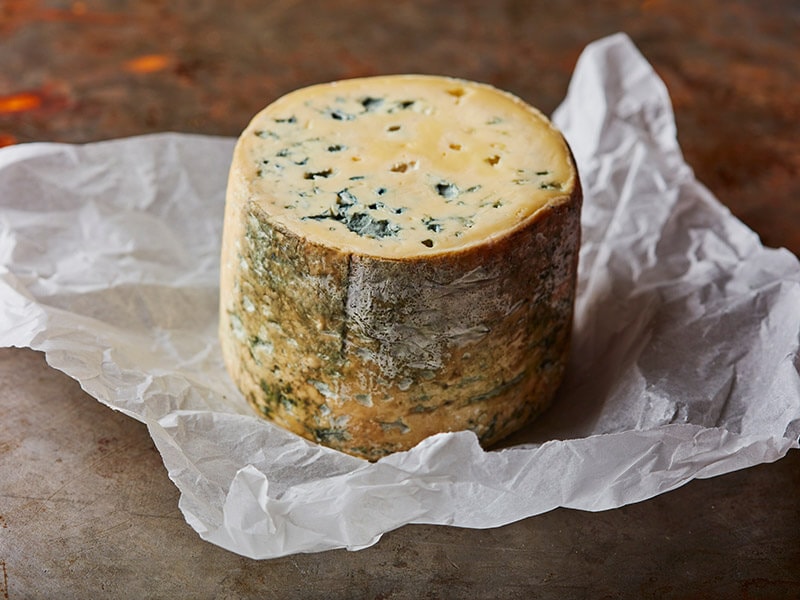
Among the three blue cheese listed here, Stilton is perhaps the most suitable for those who can’t handle the “blue.” The cheese made its first appearance in 1720 and was certified PDO in 1996.
Unlike Gorgonzola and Roquefort, Stilton is lightly veined, and this is the result of piercing its body with sharp needles. As the cheese matures, the flavor becomes more intense, and you can even sense a spicy hint laced in its creamy, crumbly interior at some point.
Highlight Characteristics
| Animal Milk | Cow’s milk, pasteurized |
| Fat Content | 35% |
| Color | Blue |
| Aroma | Strong |
| Texture | Creamy, crumbly, and smooth |
| Flavor | Strong and spicy |
Brined Cheeses
Some varieties are also called pickled cheeses, and indeed, Feta is not the only one that’s in this group. Keep reading and find out more about Sirene and Domiati in case you want some new ideas.
25. Feta
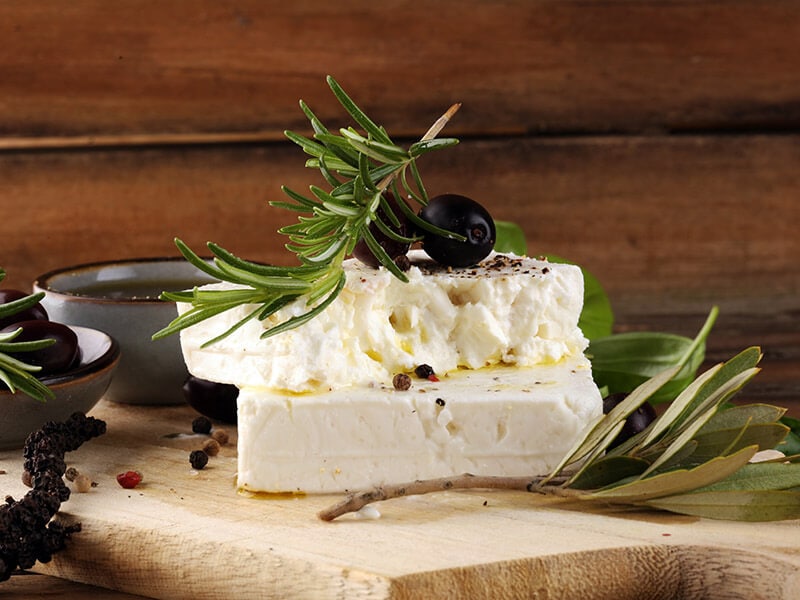
Many people consider Feta as one of the best goat cheese varieties, but little did they know that the Greek staple was originally made of sheep’s milk. It can also be made of both types of milk for a richer, more refreshing taste.
The name of this cheese means “slice” in English, a reference to the cutting of the cheese in the 17th century. You may have sprinkled feta on your salad before, but it’s time for a pace of change – try it on soup, grains, and pasta for an even more delectable combination.
Highlight Characteristics
| Animal Milk | Sheep’s or/and goat’s milk (goat’s milk must account for 70% of the amount of milk used) Can be pasteurized or not |
| Fat Content | 21% |
| Color | White |
| Aroma | Strong and nutty |
| Texture | Creamy, crumbly, and grainy |
| Flavor | Full-flavored, salty, tangy |
Here’s a breakdown of different Feta varieties for your next grocery trip.
26. Sirene
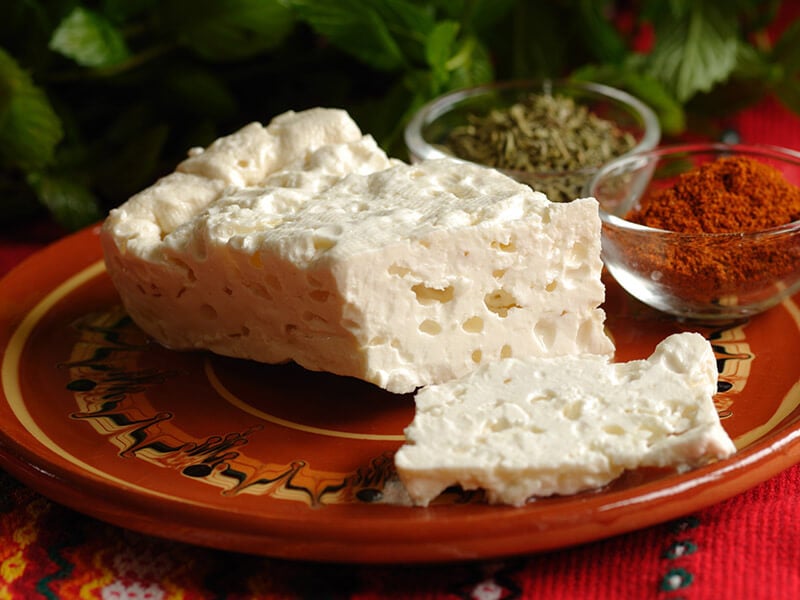
With that smooth, spreadable texture, Sirene is a great fit when Feta is not present. It is even given the nickname “Bulgarian Feta” although the cheese is not strictly produced in Bulgaria.
Nowadays, the production of this cheese also takes place in Croatia, Serbia, and Bulgaria. It has a high fat content (44-48%) and an irresistible salty, lemony taste rounded by a smooth body. The cheese is mostly used as a sprinkler for soups and salads or added to baked dishes.
Highlight Characteristics
| Animal Milk | Cow’s, goat’s, and sheep’s milk, can be pasteurized or not |
| Fat Content | 44-48% |
| Color | White |
| Aroma | Strong |
| Texture | Crumbly, grainy, and smooth |
| Flavor | Lemony, salty, sharp, and tangy |
27. Domiati
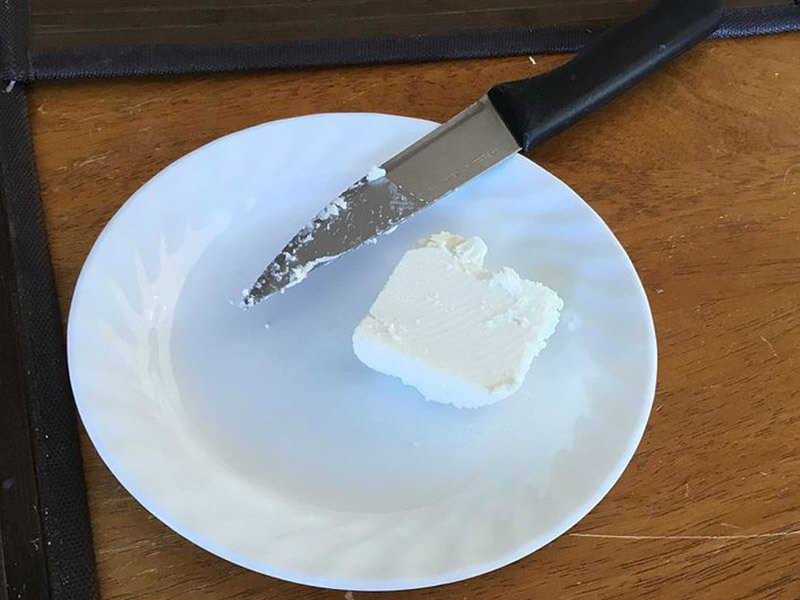
Domiati is derived from several types of milk, including camel’s.
Similar to other white cheeses, Domiati has a soft, palatable texture characterized by a salty flavor resulting from buffalo’s milk, sometimes a mixture of it with cow’s. Variants with goat’s, sheep’s, and camel’s milk are also available.
Before rennetting, salt is added to the cheese, which adds to its distinctive flavor and acts as a preservative also. Domiati is broadly consumed in Egypt, with its production now extending to Sudan and other Middle Eastern countries.
Highlight Characteristics
| Animal Milk | Traditionally cow’s and/or buffalo’s milk, sometimes sheep’s, goat’s, and camel’s milk Pasteurized |
| Fat Content | Not specific |
| Color | White |
| Aroma | Pungent |
| Texture | Smooth, soft, and crumbly |
| Flavor | Salty |
Based On Moisture Content
The cheese’s firmness is correlated to the moisture content, which can be as low as 30% or exceeds 80%. However, there’s no exact categorization by firmness since this varies greatly from variants, pressure when packed into molds, and aging time.
Soft Cheeses
Soft cheeses are relatively high in moisture (60-80%), with chevre, burrata, and mascarpone are some prominent examples.
28. Chevre
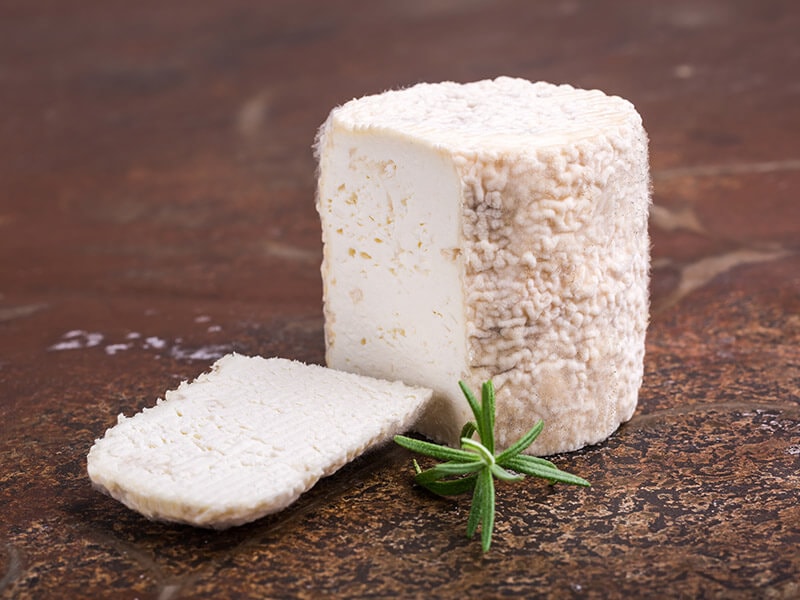
A question that never gets old: are chevre and goat cheese one? To tell the truth, it is a type of goat cheese, yet also the most sought-after one. Thus, goat cheese is sometimes used to refer to chevre, but this is not entirely correct.
Chevre offers a delectable tartness that sharpens over time. You should find fresh variants a bit less intense in taste though the acidity is still conspicuous. The cheese works well in your salad or as a partner of sweet foods like honey.
Highlight Characteristics
| Animal Milk | Goat’s milk, can be pasteurized or not |
| Fat Content | 65% |
| Color | White |
| Aroma | Earthy |
| Texture | Soft and firm |
| Flavor | Earthy, tart, and tangy |
29. Burrata
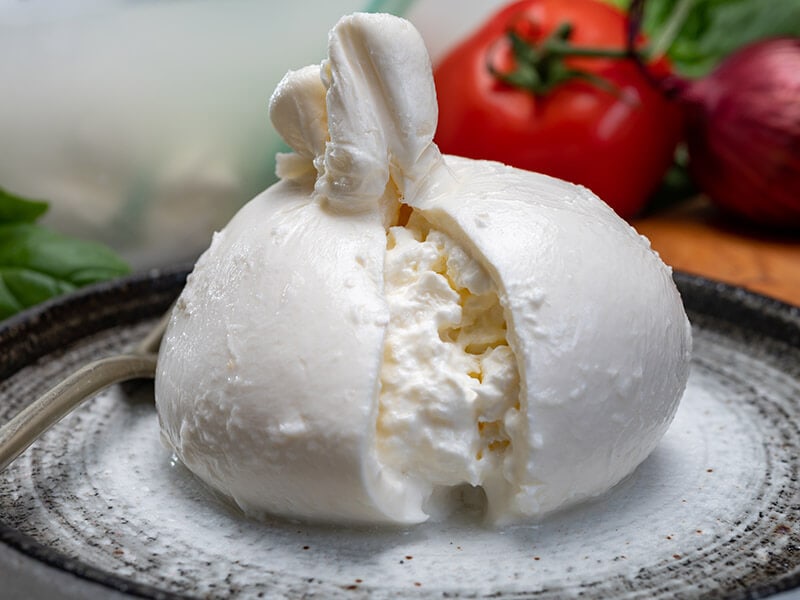
Burrata is second to none when compared to its Italian counterparts. The cheese is made up of two parts: the thin shell made from mozzarella and the soft, stringy interior, which contains the curd and fresh cream.
As a fresh cheese, Burrata is meant to be enjoyed right away: after 48 hours, the cheese will go bad. When cut open, the creamy interior oozes out, adding great flavor interest to various dishes with its mild yet refreshing taste.
Highlight Characteristics
| Animal Milk | Water buffalo’s milk, can be pasteurized or not |
| Fat Content | 20% |
| Color | White |
| Aroma | Fresh and milky |
| Texture | Creamy and stringy |
| Flavor | Buttery and milky |
30. Mascarpone
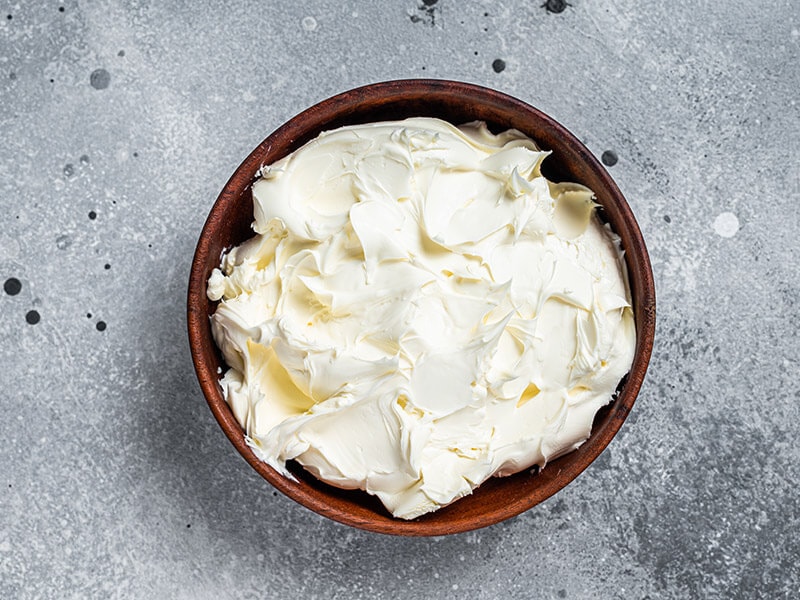
Mascarpone with strawberries? Yummy! Mascarpone with salmon? Another level! It is not an overstatement to say that Mascarpone is one of the most pantry-friendly ingredients because it is. You can have it with anything, really, even vegetables!
Many people have probably mistaken it for goat cheese, but it’s not one. Mascarpone is less sticky, and its taste is not salty or tangy. On the dot, think of it as cream cheese but with the right touch of sweetness and acidity.
Highlight Characteristics
| Animal Milk | Cow’s milk, pasteurized |
| Fat Content | 60-75% |
| Color | White |
| Aroma | Fresh |
| Texture | Buttery, creamy, smooth, and spreadable |
| Flavor | Buttery, creamy, and milky |
Semi-Soft Cheeses
Semi-soft cheeses are also high in content but not as much as fresh counterparts. They are great for slicing or snacking and do not have rind (or very little rind). Havarti, Port Salut, and Munster are some common examples you want to check out.
31. Havarti
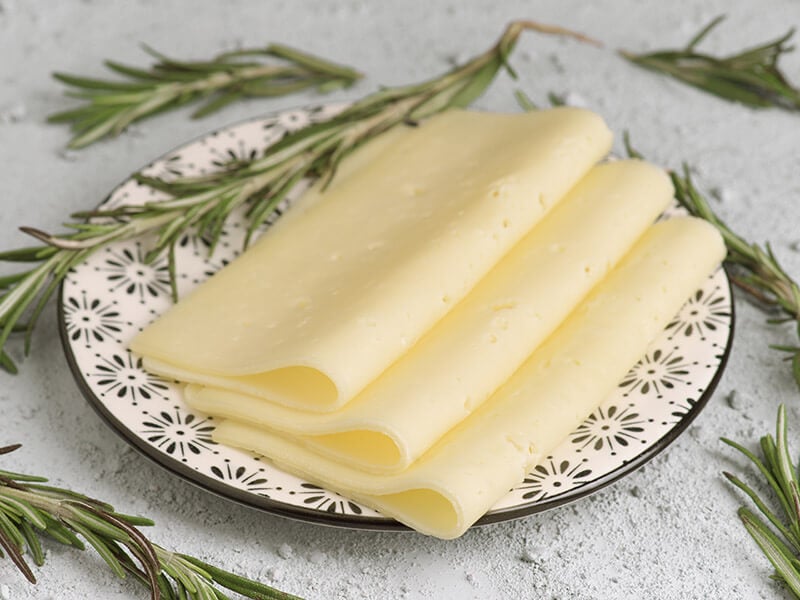
What’s waiting for you behind the creamy interior of Havarti? Native to Denmark, this cheese knows how to seduce everyone with its smooth consistency. A seamless transition is created between sweet and buttery notes echoed by a slight acidity as a finishing touch.
As it ripens, the flavors become more intense on your palate. For a more elaborate twist, opt for creamy Havarti, which has been enriched with extra cream, or smoked Havarti, a version that cuts back on the heavy creaminess.
Highlight Characteristics
| Animal Milk | Cow’s milk, pasteurized |
| Fat Content | 11% (45% in dry matter) |
| Color | Pale yellow |
| Aroma | Sweet |
| Texture | Smooth |
| Flavor | Buttery, creamy, and sweet |
32. Munster
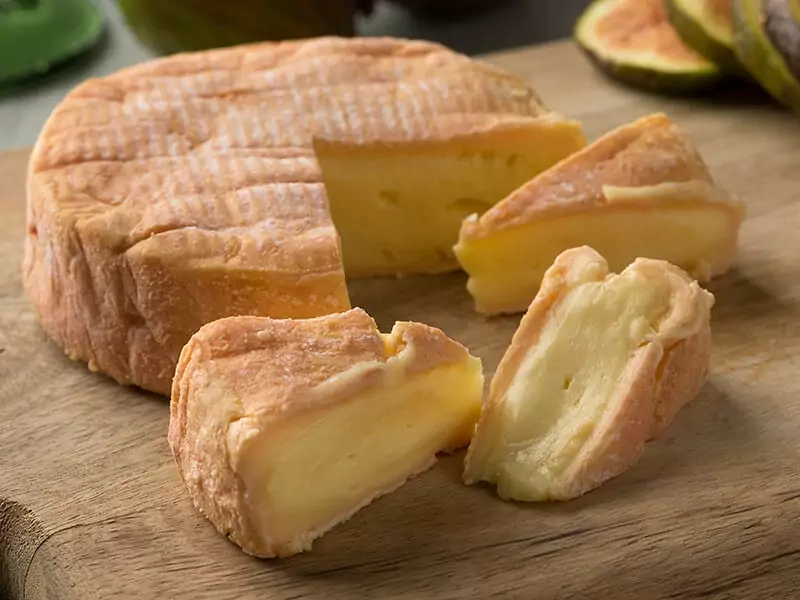
Like other washed-rind cheeses, Munster is treated with brine for weeks (sometimes months in case of large wheels), resulting in a particular red smear on its rind. Underneath that lies a mild, buttery interior echoed with hints of cumin and a tangy finish.
The production of Munster began in Admodiation. Originally, the cheese used to be a means of debt payment, and not until the 17th century did this practice disappear. Nonetheless, two regions, Munster and Géradmer, keep it alive and going strong.
Highlight Characteristics
| Animal Milk | Cow’s milk, unpasteurized |
| Fat Content | 45-50% |
| Color | White |
| Aroma | Strong and stinky |
| Texture | Smooth, creamy, and sticky |
| Flavor | Savory and tangy |
33. Port Salut
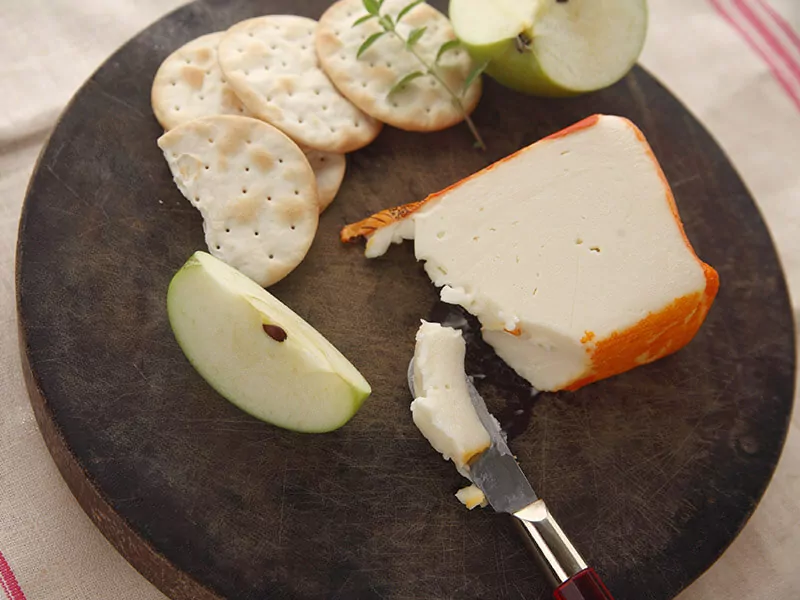
Loire Valley is well-known for its diverse cuisine. If you get the chance to stop by, don’t forget to snag yourself some Port Salut (or Port du Salut in French), a washed rind cheese that has a smooth pale yellow interior.
Trappist monks first produced this cheese in the 19th century. Since then, the cheese rose to fame for its mild, mellow flavors, which make a great filler on any cheese platter or provide your dishes with a nice creamy touch.
Indeed, Port Salut does not say no to fresh fruits and vegetables. Don’t forget to drizzle olive oil and balsamic vinegar for a more well-rounded flavor.
Highlight Characteristics
| Animal Milk | Cow’s milk, pasteurized |
| Fat Content | 72.7% |
| Color | Pale yellow |
| Aroma | Mild |
| Texture | Smooth and creamy |
| Flavor | Mellow, sweet, and savory |
Semi-Hard Cheeses
Striking the right balance between moisture and aridity, semi-hard cheeses are aged for about one to six months. The outcome is terrific: a springy texture with savory and tangy flavors, in addition to a mild aroma that goes easy on everyone.
34. Cheddar
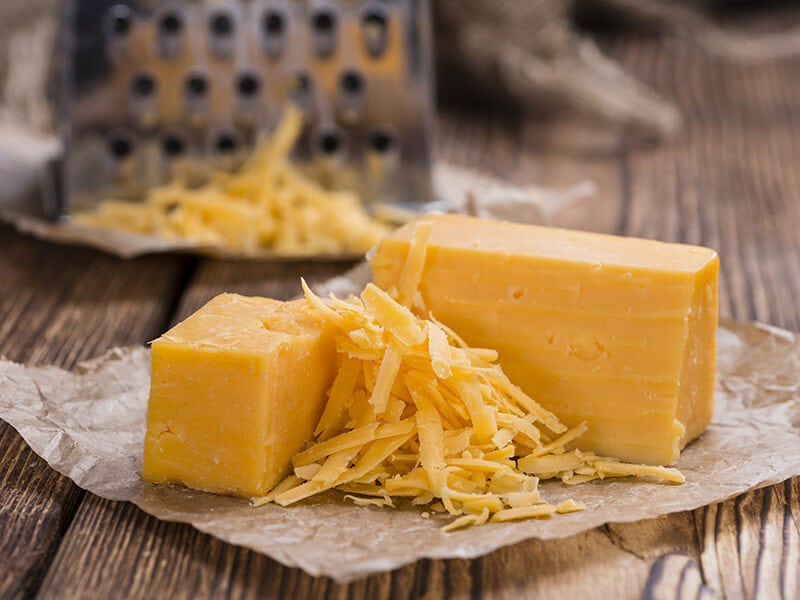
Made in England in the 12th century, Cheddar has found a way to put its name on the map with its exquisite flavor, which ranges from mild to sharp depending on the cultures used and the aging of the cheese.
Nowadays, you can find high-quality Cheddar everywhere, with a smooth exterior in white or pale yellow. However, that comes with a bad rap because products outside England are often low-quality. Aside from savory applications, the cheese can go with fruits and nuts.
Highlight Characteristics
| Animal Milk | Cow’s milk, often pasteurized |
| Fat Content | 9% |
| Color | Pale yellow, sometimes orange |
| Aroma | Sour |
| Texture | Very hard |
| Flavor | Creamy and sharp |
35. Monterey Jack
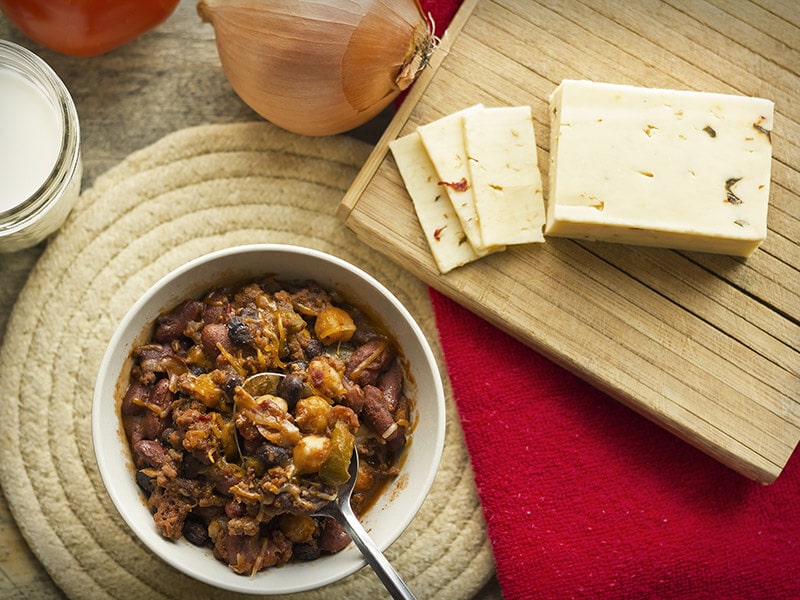
You may have heard people called Jack, sometimes Pepper Jack, which is actually a variant of Monterey Jack that contains different sorts of chilis. The American cheese was invented in the 1700s and can now be found in many states of America, not just in Monterey county.
The cheese is aged six weeks to three months, yet the flavor is relatively mild and buttery. Its high melting point makes it a splendid melter for sandwiches, pasta, and soups. Dishes that normally call for cheese like casserole or mac and cheese love some Monterey Jack, too.
Highlight Characteristics
| Animal Milk | Cow’s milk, pasteurized |
| Fat Content | 74.6% |
| Color | Pale yellow |
| Aroma | Aromatic |
| Texture | Compact, creamy, and supple |
| Flavor | Mild and buttery |
36. Colby
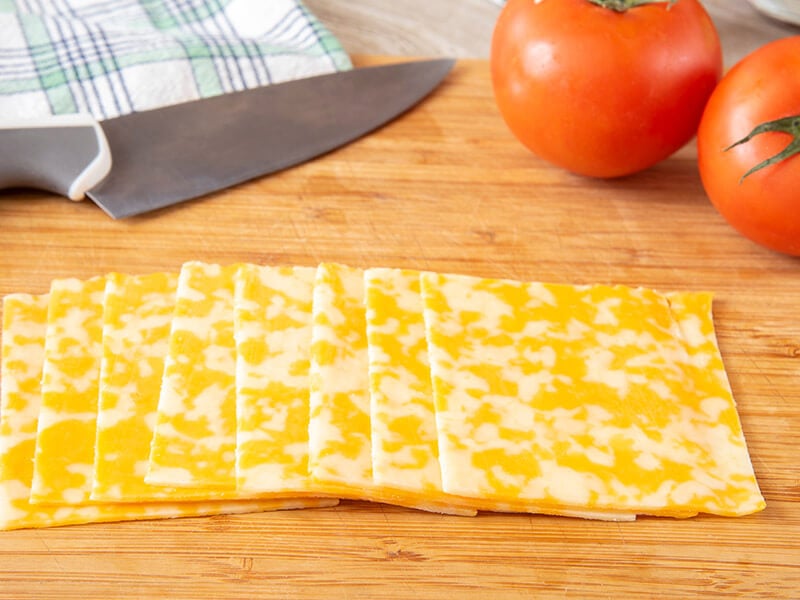
Nicknamed “longhorn,” Colby knows how to make an entrance on the table with its attractive golden hue. The cheese often teams up with Monterey Jack, another semi-hard cheese you will meet below, for a marble cheese known as Colby Jack, or Co-Jack for short.
Colby is like a blank canvas: it is relatively mild in taste, with some even claiming it lacks that X factor. Hence, people will mostly serve it as a table cheese or combine it with Cheddar and other cheeses for a more well-rounded flavor.
Highlight Characteristics
| Animal Milk | Cow’s milk, pasteurized |
| Fat Content | 31-32% |
| Color | Yellow (sometimes dyed to appear orange) |
| Aroma | Mild and sweet |
| Texture | Firm, open, and springy |
| Flavor | Mild and sweet |
Hard Cheeses
As the name implies, hard cheese is firm to touch. The cheese’s density is the result of years of aging, which also lends the cheese a sharp, intense flavor. People often use these sorts of hard cheeses for grating, adding to the recipes a lingering kick that can wow any taste buds.
37. Parmesan
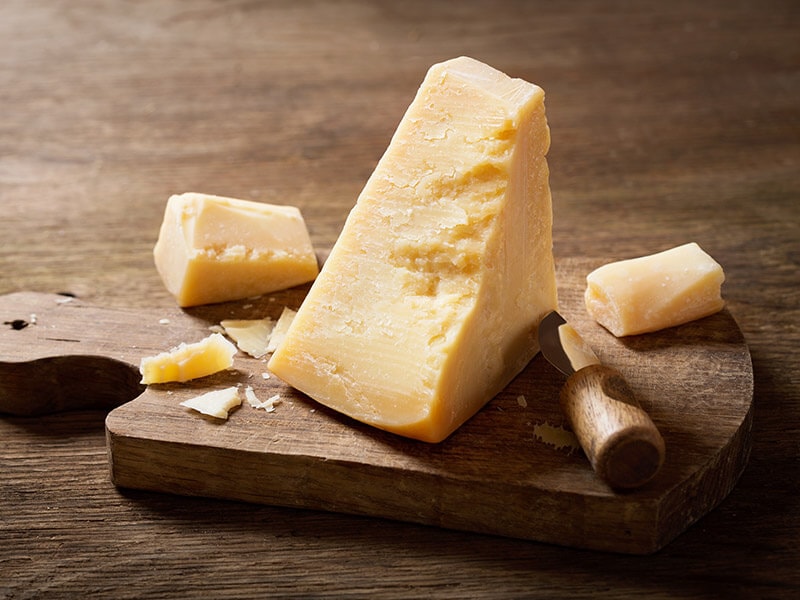
When asked which cheese makes a great pairing with Mozzarella, there are various answers – but you know the truth that Parmesan is its best match. The hard, granular-based cheese is made of cow’s milk and has been produced in Italy for around nine centuries.
Its origin dates back to as far as 1200, and over the flow of time, the cheese has earned high praise for its flavor. It has an intricate taste, opening with nutty undertones and leaving with a sharp yet delightful aftertaste. Spice up its flavor with apples, pecans, or honey, you name it.
Highlight Characteristics
| Animal Milk | Cow’s milk, pasteurized |
| Fat Content | About 25% |
| Color | Straw |
| Aroma | Strong, somewhat stinky |
| Texture | Crystalline, dense, and grainy |
| Flavor | Sweet, nutty, salty, fruity, and savory |
Parmesan is expensive, yet worth every penny. Find out the reason here!
38. Pecorino
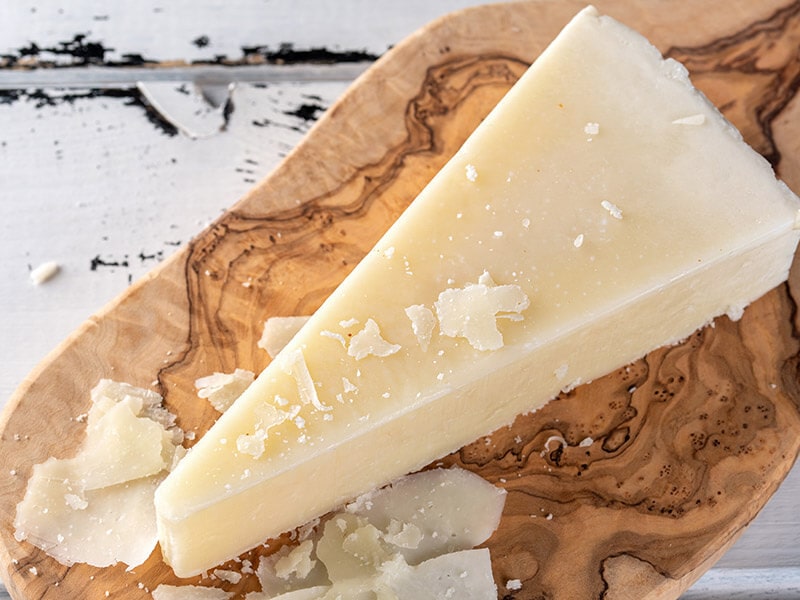
Pecorino, short for Pecorino Romano, is another hard Italian cheese you want to add to your cooking arsenal. It is one of the oldest cheeses of this country and normally used for grating, but its rich taste also makes it an exceptional melter for pasta.
It is pretty similar to Parmesan, but perhaps true only if you are talking about the appearance or the place of origin. Regarding the taste, Pecorino suggests grassy, earthy nuances, which are not what Parmesan can promise to deliver.
Highlight Characteristics
| Animal Milk | Sheep’s milk, can be pasteurized or not |
| Fat Content | 50% |
| Color | Pale yellow |
| Aroma | Strong |
| Texture | Crumbly, dense, and grainy |
| Flavor | Sharp, smokey, and salty |
39. Grana Padano
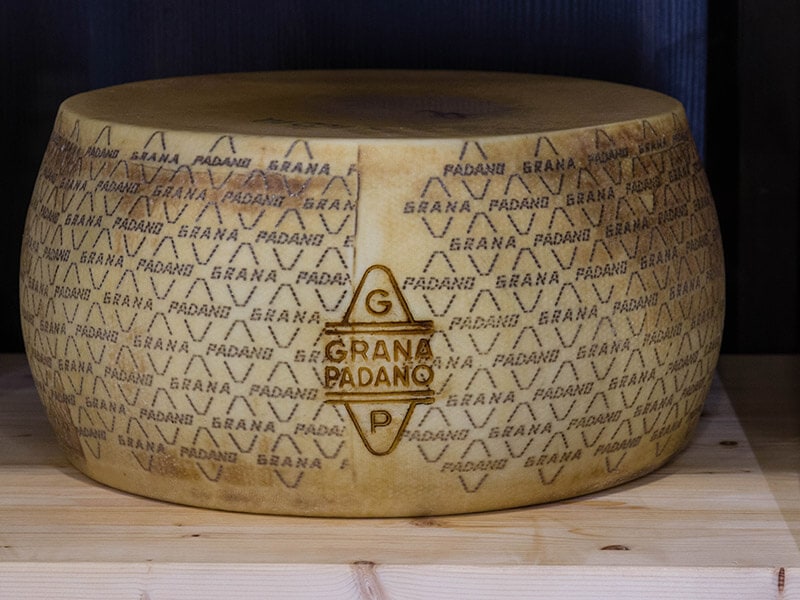
Granted DOP on 12th June, 1996, Grana Padano since then has given the perennial favorite Parmesan some tough competition. The cheese delivers a full-bodied flavor, which is a blend of fruity and nutty nuances that crumbles in your mouth with every bite taken.
The cheese has several culinary applications, but often people will use it to amp up the taste of other mild cheeses. Alternatively, dust it over salads or soups or pair it with cured meat for a heavenly flavor combo.
Highlight Characteristics
| Animal Milk | Cow’s milk, unpasteurized |
| Fat Content | 39-41% |
| Color | Pale yellow |
| Aroma | Fragrant |
| Texture | Crumbly and grainy |
| Flavor | Rich, fruity, and slightly nutty |
That’s The Cheese!
With my list of the best types of cheese, I’m certain that your meal will be far more enjoyable from now on. Be it the classic Parmesan or the Gorgonzola with an off-putting smell, you can always have a ball when cheese is on the table.
Which ones on the list are your favorite? Which ones do you plan to put on your platter next? Share your two cents with other readers and me via the comment section. I’m waiting to hear all your takes!
